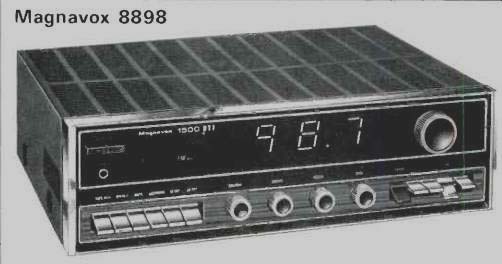
MANUFACTURER'S SPECIFICATIONS
FM TUNER SECTION
IHF Sensitivity: 3.0 µV.
S/N Ratio: 50 dB.
THD (Mono): 1.0%.
Selectivity: 60 dB.
Capture Ratio: 4 dB.
Image Rejection: 75 dB.
I.F. Rejection: 100 dB.
Spurious Response: 75 dB.
AM Rejection: 35 dB.
Stereo FM Separation: (1 kHz) 35 dB.
AM TUNER SECTION
IHF Sensitivity: 400 µV/M.
Image Rejection: 40 dB.
I.F. Rejection: 30 dB.
Selectivity: 20 dB.
AMPLIFIER SECTION
Continuous Power Output: 50 watts/channel.
Rated THD: 0.5%.
Rated IM: 1.0%.
Power Bandwidth: 15 Hz to 20 kHz.
Damping Factor: 30.
Hum and Noise: Phono, 60 dB Aux, 75 dB; Tape Monitor, 75 dB.
Input Sensitivity: Magnetic Phono, 2 mV; Ceramic, 1 50 mV; Aux, 1 50 mV; Tape Monitor, 400 mV.
Frequency Response: 20 Hz-25 kHz 71 dB.
GENERAL
Dimensions: 18 in. W. x 5 1/4 in. H. x 14 1/4 in. D.
Maximum Power Consumption: 300 VA.
Price: $479.95 (minimum retail price, applicable in fair trade states).
The Magnavox 8898 Receiver is the first entry in the component high fidelity field by a firm that had, since its inception, steered clear of this segment of the home entertainment market. We must admit, at the outset, that the mere name suggested "console" design philosophy and compromises all too familiar to the knowledgeable audio enthusiast. After objectively measuring and testing this first unit, however, our fears were dispelled.

Fig. 1-Rear panel
Evidently determined to enter the component world with a bang and not with a whimper, Magnavox has come up with a handsomely styled, amply dimensioned receiver that sports by far the largest digital readout system we have thus far encountered. The upper portion of the front panel is "blacked out" until power is applied; when either AM or FM is selected, red numerals measuring over one inch in height appear, denoting the frequency to which the receiver is tuned. Tuning is accomplished by a massive 11 in. knob at the right which is coupled to a flywheel. In the FM mode, the letters FM-MHz also appear alongside the numeric readout, while in AM, the letters AM-KHz appear alongside the numbers. The upper portion of the panel also contains a pair of speaker pushbutton switches of the push-push variety, enabling sole use of the headphone jack, located just below, when neither the "A" or "B" speaker switch is depressed.
The lower portion of the panel has a walnut-finish decorative inset section. At the left are six chrome plated "piano key" switches governing such functions as TAPE MONITOR, STEREO/MONO Mode, MUTE, LOUDNESS, and HI CUT and LO cur Filters. As these switches are depressed, appropriate illuminated words appear in an otherwise blacked-out area above them. The four rotary controls which follow are for adjustment Of BALANCE, VOLUME, TREBLE and BASS. Finally, at the lower right, there are five more "piano-key" switches. The first, colored red, applies power to the unit while the others (again chrome plated) select program sources. These last four are of the interlocking type so that only one can be depressed at a time.
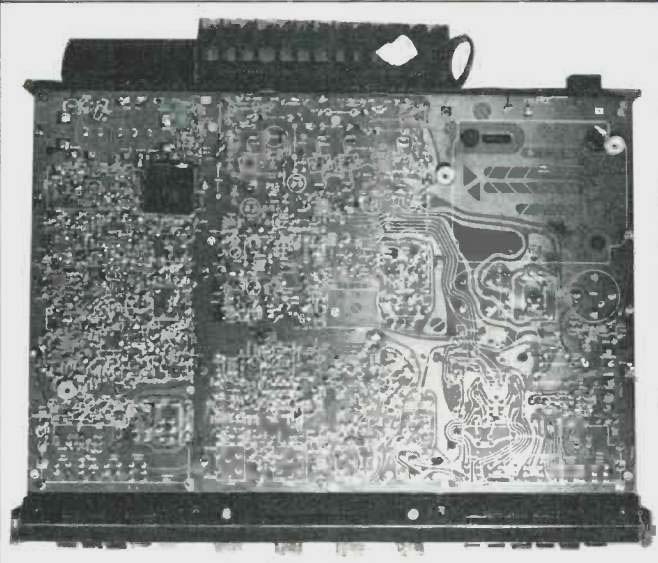
Fig. 2-View of the chassis from below.
The rear panel, shown in Fig. 1, is equipped with the usual input and tape monitor in and out jacks. A switch located below the phono input jacks selects, the proper pair of jacks for either magnetic or ceramic cartridges. Below the pivotable AM loopstick antenna are a pair of screw terminals for connection of a 300 ohm FM antenna transmission line. The entire center section of the rear, panel is occupied by a large, ribbed heat sink while to the right are color coded, spring loaded terminals which make speaker cable connection easy and short-circuit-proof, since the stripped ends of the speaker wires are simply inserted in holes which are exposed when the terminals are depressed. A line fuse is located just above the convenience a.c. outlets, one of which is switched-the other unswitched. Finally, borrowing from one of the good design points in "console" manufacture, Magnavox has included a "changer power" receptacle. Changers equipped with a matching three-terminal plug (and Magnavox changers are so-equipped) can be connected to this receptacle instead of to the usual standard a.c. receptacle. When so connected, the record changer's automatic shut-off switch also shuts off power to the receiver after the last record has been played. As supplied, the receiver is fitted with a shorting plug so that normal operation of the front panel power on-off switch takes place even if such specially equipped record changers are not used with this receiver.
Circuitry and Layout
The Magnavox 8898 receiver is built on a foundation of what is probably the largest single p.c. board we have yet seen, as shown in Fig. 2. Despite its size, however, there seems little danger of breakage, since the board is well "anchored" to its supporting chassis frame. As can be seen in the top view of Fig. 3, an additional p.c. board, equipped with a variety of IC's, is mounted "piggy back" above the main board and takes care of the digital readout functions.

Fig. 3-View of the chassis from above.
R.f. circuitry includes a MOSFET r.f. amplifier stage and four tuning sections in a conventional variable capacitor arrangement. Thus, the local oscillator is quite conventional and unrelated to the digital readout system. The digital circuits merely "read" the frequency of the oscillator and, in effect, subtract 10.7 MHz from that reading to give a display which corresponds to the incoming r.f. frequency. In short, all the extra IC's and the read-out tubes simply replace a conventional dial pointer and calibrated dial scale. This nicety is not to be confused with other digital systems which control oscillator frequency through the use of phase-lock-loop circuits, etc.
IC's are used in the FM and AM i.f. circuitry, as well as in the stereo multiplex circuits and the phono preamplifiers.
Output circuitry is direct coupled and of the quasi-complementary type. Output transistors are fused and there is a thermal cut-out switch on the main heat sink and a current limiting circuit for the output stages.
Electrical Measurements
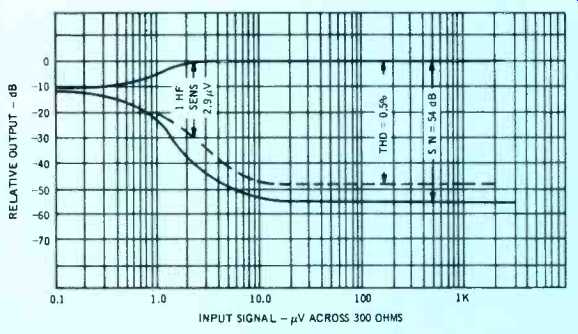
Fig. 4-Mono FM characteristics

Fig. 5-Stereo separation and distortion characteristics.
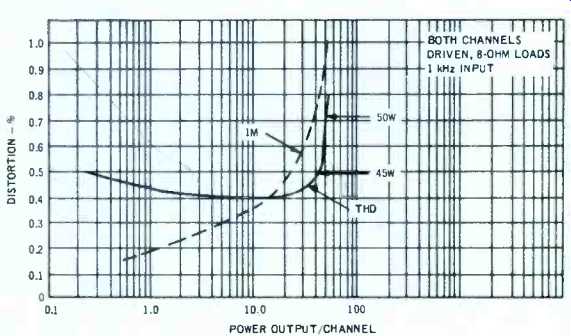
Fig. 6-THD and IM characteristics.
The manufacturer's specifications listed above are said to be "minimum" specifications and in most cases this turned out to be ture. Nevertheless, examination of them will disclose that they do not represent the kind of "state of the art" numbers that we have been accustomed to seeing lately. For example, the ultimate S/N in FM is stated as a minimum of 50 dB. Our actual measurements gave a reading of 54 dB, as shown in Fig. 4. While this is certainly a quiet enough signal for ordinary FM listening, it falls short of the "critical listening" kinds of readings we have been observing on other recently designed receivers. Some 60 dB or better has been the norm, with exceptional units often producing 65 or even 70 dB of ultimate S/N. It should be pointed out that the residual content at -54 dB observed on this unit consisted primarily of power supply hum components rather than wide-band noise.
THD in mono FM on the other hand was a very respectable 0.5% as claimed and, as shown in Fig. 5, the THD in mono never exceeds 1.0% at any audio frequency of listening significance. IHF sensitivity measured 2.9 µV, a bit better than claimed.
Stereo FM separation fell a bit short of claims, measuring 30 dB at mid-band and decreasing to 20 dB at 10 kHz and about 23 dB at 50 Hz. THD in stereo FM was also quite acceptable, remaining under 1.5% from 50 Hz to about 6 kHz.
One thing that can be said for the digital readout scheme as used in this and other receivers we have tested is that "calibration" is perfectly accurate. Because of the crystal "clock" reference used in these counting circuits, when the readout reads 103.5 you can be certain that that is the exact frequency to which you are tuned. Of course, the readout is given in increments of 100 kHz (0.1 MHz) so, in theory, you could be off by as much as 50 kHz in either direction, but we found that as you approach the next tenth of a MHz there is a tendency for the last digit to pulsate between the two alternate tenths, giving you the clue that you are perhaps too close to the next tenth of a MHz. With this type of readout method, however, we still feel that a center-of-channel meter or some other center-tune indicator would be useful and competitive receivers in this price category usually offer such a meter.
With both channels driven, we were able to obtain 46 watts continuous output per channel at 1 kHz before reaching 0.5% rated distortion. Rated power output of 50 watts per channel was reached with a THD of 0.7%, as shown in Fig. 6. At all power levels tested below 46 watts per channel, THD never exceeded rated values of 0.5%. IM distortion, also plotted in Fig. 6, was quite low at nominal listening levels but tended to rise a bit sharply above 20 watts, reaching the 1.0% rated value at exactly 50 watts per channel.
At half-power and one-watt levels, THD remains below 0.5% for all audible frequencies, as shown in Fig. 7, while power bandwidth extends from 20 Hz to just above 25 kHz, as claimed and as plotted in Fig. 7. Fifty watts per channel was used as the "0 dB" reference in these measurements.
Tone control, loudness and filter characteristics for the Model 8898 are plotted in Fig. 8. Both filters have a slope of 6 dB per octave, but since the cross-over points are at about 100 Hz and 4 kHz their effectiveness is greater than that which might be obtained by simply rotating both tone controls clockwise to get rid of rumble and/or record scratch and noise. The loudness compensation characteristic for a-30 dB setting of the volume control is also plotted in Fig. 8 and Magnavox has elected to compensate slightly at the high end, in addition to the usual boosting of the low end.
Listening Tests and Additional Operating Features
The Magnavox 8898 receiver was subjected to approximately two weeks of normal use and performed well during that time. For our low efficiency speakers, power was ample and sound was generally clean. We found station tuning to be a bit critical, particularly on AM, where even slight rotation of the tuning knob results in a shift of frequency of several kHz (one full turn of the knob moves the frequency over 100 kHz, which means that resolution accuracy of 1 kHz in AM tuning requires being able to resolve 1/100 of a full rotation of the knob).
When the mute and stereo switches are actuated together, the receiver will allow only stereo signals to be heard while in the mono mode, the mute switch performs as strictly an inter-station noise suppressing circuit. Mute settings are not adjustable by the customer and, in our model, muting was overcome at just under 10 microvolts of signal strength. Tuning drift was minimal and did not shift frequency enough to cause audible distortion in either AM or FM after a few minutes warm-up.
We logged 42 acceptable FM signals with the aid of our outdoor antenna aimed westward (towards New York City). Of these, 21 were stereo transmissions. AM reception was average, with sensitivity a bit lower than expected, though bandwidth seemed adequate.
We examined the instruction booklet in some detail and found it easy to follow and well organized. We did discover another feature which had escaped our attention when we measured the receiver on the test bench. Just under the stereo indicator light, in the right-hand section of the blacked-out dial area is a second indicator identified in the instruction booklet as the OVERHEAT INDICATOR. This lamp is associated with the thermal cut-out switch near the output transistors and, of course, it did not become illuminated during our normal tests. In order to see it work (and to confirm its effectiveness), we took the unit back to the test bench, hooked up 8-ohm loads and fed a moderate signal to the receiver while at the same time short-circuiting the speaker output terminals.
After a few minutes-sure enough the front panel indicator did become illuminated and the current drive was removed from the output stages-protecting the output transistors from accidental failure. The presence of the light is a good indicator to the consumer that something is wrong, even though no permanent damage has been done.

Fig. 7-THD vs. frequency at various power levels.
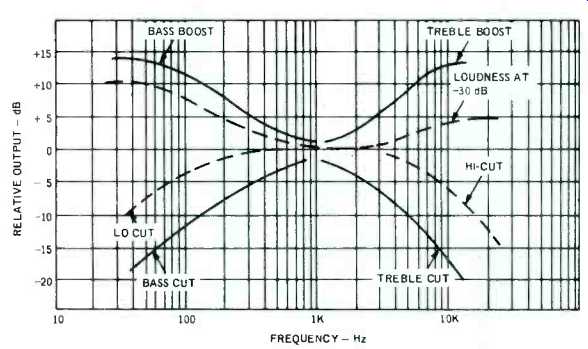
Fig. 8-Tone control characteristics.
Summary
As a first effort, this Magnavox unit certainly qualifies as a high-fidelity stereo component receiver. While the digital readout feature adds to the cost while providing no real audible benefit, this is probably off-set in part by Magnavox's ability to produce large runs of a product efficiently and economically. Specifications, both published and confirmed, are good though not spectacular, particularly in the FM section. From a listening point of view, however, the unit performs quite well. We would like to see future products with lower overall distortion in the audio section and better quieting characteristics in the FM portion.
-Leonard Feldman
Correction:
The price of the ESS Mk VII Speaker System is $229.00, not $299.00 as stated in January Audio which makes it an even better buy for the money.
( Audio magazine, Mar. 1973)
Also see:
Magnavox MAX 12 Loudspeakers (Equip. Profile, May 1974)
Magnavox CD650 CD player (Mar. 1987)
= = = =